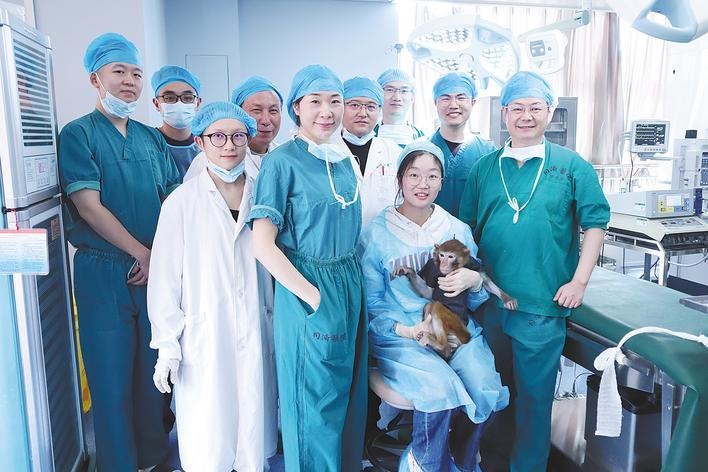RELAXED, REFINED — FOREIGN VISITORS IMPRESSED BY 'SHOPPING PARADISE'
Ease of access, instant tax refunds, quality products winning over inbound travelers

While strolling around Shanghai's trendiest shopping precinct on their visit, Vietnamese couple Nhu Truong and Tu Vo had an unexpected opportunity to take part in an exciting new retail trend.
In upmarket Shanghai Xintiandi, the two 30-year-olds noticed an outlet of Harmay — a Chinese multi-brand retailer known internationally for its warehouse-style approach to sales.
Vo, an investment manager at a bank in Vietnam, said that before their five-day Shanghai visit they had watched many TikTok videos of people shopping in Shanghai who shared information about buying reasonably priced cosmetics.
"We were just walking around and I noticed the store's name, which is so familiar. So we immediately went inside to buy something," Vo said.
In addition to cosmetics, the couple purchased skin care and health products, including mini and travel-size items, hallmark products of the company.
Established in 2008, Harmay started out as an online cosmetics retailer. However, to attract a younger trend-driven generation of consumers they subsequently introduced warehouse-style shopping at offline stores.
Harmay offers over 800 global brands and has more than 25,000 stock-keeping units, a unique code used to identify each product in its inventory. With monthly updates of over 1,000 products, it keeps expanding its product inventory to not only include leading brands, but also many unique and niche ones from China and overseas.
This strategy to quickly update its product lines and its wide range of selections have boosted brand recognition among global consumers. Harmay has over 1.5 million followers on social media platforms, and its membership now exceeds 4 million customers worldwide.
It has 19 brick-and-mortar stores in 10 cities across China featuring unique designs tailored to local cultures. They have become popular destinations for international tourists seeking unique travel and shopping experiences.
As China draws increasing numbers of inbound travelers, Harmay has seen a sharp growth in inbound consumption at all its stores. In June, over 30 percent of its Shanghai Xintiandi store revenue came from international travelers, with tourists from the Middle East and Asian countries including South Korea and Singapore, the top shoppers.
Since the store launched a departure tax refund service on June 19, it has issued more than 2,000 applications for international visitors.
Policy boost
International visitors' big spending in Shanghai Xintiandi epitomizes the city's and nation's growing reputation as a shopping paradise, largely driven by China's constantly expanding visa-free and optimized tax refund policies.
As of June, China's 240-hour transit visa-free policy has been extended to 55 countries in Europe, the Americas, Oceania and Asia, according to the National Immigration Administration.
The number of foreigners coming to China visa-free increased significantly in the first six months of the year, the NIA announced on July 16. From January to June, immigration authorities across China recorded a total of 13.64 million visa-free inbound trips made by foreigners, up 53.9 percent year-on-year.
China has also fine-tuned its departure tax refund policies, and boosted shopping convenience for global visitors.
Foreign visitors are eligible to claim departure tax refunds for purchases as low as 200 yuan ($27) per day at the same store, compared with the previous threshold of 500 yuan, and can get instant cash refunds up to 20,000 yuan, according to a new policy released in April.
Ongoing efforts are also being made to widen the scope of refundable goods, expand tax refund stores, and streamline refund procedures to offer efficient optimized services.
The policy highlighted the instant departure tax refund service, or, the "refund-upon-purchase" model. The service allows foreign tourists to claim value-added tax refunds at the stores, or nearby refund counters, rather than waiting until they leave the country. The measure is intended to encourage them to spend the refund on more shopping, according to the State Taxation Administration.
Last year, total spending by inbound travelers hit $94.2 billion, up 77.8 percent year-on-year. The nation sees substantial growth potential in the inbound consumption sector, and plans to increase the number of tax refund stores to about 10,000 nationwide this year, according to the Ministry of Commerce.
Shanghai is ramping up its efforts to become an international shopping center. As one of the first Chinese cities to implement the departure tax refund policy in 2015, it also took the national lead in piloting the instant tax refund service in January 2019.
Over the past decade, the number of tax refund stores in Shanghai has grown from 27 to over 1,400, covering shopping malls, traditional markets, intangible cultural heritage workshops, time-honored brands as well as high-end and flagship stores of international brands.
Seamless experience
Digital services and upgraded measures by local governments are also contributing to the "shopping in China" boom.
The Vietnamese couple who shopped at Harmay quickly got their tax refund at the store, and were soon searching for a phone app for a place to buy tea, snacks and local souvenirs. Despite their short stay in Shanghai, they became familiar with local mobile apps and online platforms such as Dianping and Meituan.
"We use them for food delivery services every day. They are really easy to use and we researched a lot on them," says Nhu Truong, an IT developer.
To help visiting foodies select delicacies in Shanghai, Dianping, a popular online review platform, provides a "must-eat" list in Chinese, English and Korean. It is one of the latest efforts to facilitate foreigners' travel experience and boost inbound consumption, under the recently launched 2025 Shanghai Summer International Consumption Season.
Under the promotion event, China Eastern Airlines is set to offer over 1 million discount flights, while ride-hailing platform Didi will distribute 1 million coupons.
Taxis will be equipped with point-of-sale machines to allow direct payment with foreign bank cards, and over 200 Jinjiang International Holdings hotels will offer discounts for international travelers.
Johannes, a 35-year-old science teacher from Germany, took advantage of the visa-free policy to make his first visit to China recently. He used Amap, a leading Chinese digital map provider, to navigate his way around Shanghai, and made purchases with Alipay.
A uniquely decorated glass store popular on Instagram as well as travel experiences shared by his friends, enticed Johannes to visit Shanghai Xintiandi.
"It is a very enjoyable experience here as everything is seamless. People are very nice and the city is modern, very beautiful and convenient. It is a mega city, but it is actually quieter than I thought," he said, noting that he planned to see the historic French buildings and try some tasty xiaolongbao steamed buns at Yuyuan Garden.
To add to the "seamless experience", foreign visitors can buy a Shanghai Pass, which offers a range of discounts for public transport, sightseeing, dining and shopping.
Tax refund counters with multi-language services are also spreading in the city's major shopping areas. International visitors can get their refunds instantly on site in cash, or with Alipay.
The city's first collective departure tax refund counter opened on the Bund last month, enabling visitors to get refunds for all their purchases made at any eligible store in the city. So far, 17 such counters have been set up across Shanghai.
On Alipay, global visitors can use the Easy Go platform for services including food delivery, public transport and ride hailing, information on city attractions, booking tickets, and shopping. The English-language version of the platform supports real-time translations in 14 languages to serve visitors from across the globe.
Nationwide boom
As an international city, Shanghai authorities and businesses are well aware of the need to offer a diverse range of products and experiences to visitors from different countries and regions.
In early July, children from Brazil, Switzerland and Lithuania were excitedly looking for the globally popular Labubu plush toys at a Pop Mart store on the city's East Nanjing Road.
In the same area, Indian tourists Vipulq and Itika said they were impressed by the city's fashion culture as well as the quality and affordability of most products.
At Yuyuan Garden, where international tourists often buy traditional Chinese cultural products, intangible cultural heritage crafts and delicacies, two Romanian students told China Daily they planned to purchase some pearl accessories. There was also a variety of souvenirs, snacks, silk dresses and mooncakes, which they were interested in.
In the first half of this year, Shanghai welcomed over 4.24 million inbound tourists, up 38.5 percent year-on-year. The sales of departure tax refundable goods grew 85 percent year-on-year during the period, with the sales of goods with instant tax refunds surging 28.1-fold.
The Shanghai Municipal Tax Service of the State Taxation Administration said over 63,000 international travelers from 167 countries and regions received departure tax refunds in the first half of the year.
Beijing also launched the departure tax refund service a decade ago in a bid to draw larger numbers of foreign tourists.
The city received 2.46 million inbound tourists in the first half of the year, up 48.8 percent year-on-year, according to Beijing Municipal Bureau of Culture and Tourism data.
Beijing has seen average monthly sales of departure tax refundable goods exceed 100 million yuan at over 1,400 tax refund stores across the city this year.
Chinese brands and products accounted for 40 percent of the total refunds, according to the Beijing Municipal Tax Service of the State Taxation Administration.
In Guangdong province, Shenzhen has seen sales of departure tax refundable goods grow 2.45-fold so far this year. Sales of goods with instant tax refunds recorded a 22-fold increase by June 10.
By May 22, Guangzhou had witnessed sharp growth in inbound tourists from Southeast Asian countries, with total inbound visitors expanding 57.86 percent year-on-year and inbound spending increasing 68.63 percent year-on-year, according to data from Chinese online travel agency Ctrip.
In Southwest China, Chongqing is also drawing massive numbers of international visitors, with over 775,000 inbound visits from January to May, an 82.1 percent year-on-year rise.
Chengdu in Sichuan province welcomed more than 984,000 inbound visits in the first half of the year, surging 51.5 percent year-on-year.
In the first quarter of this year, Chengdu recorded 270 percent growth in sales of departure tax refundable goods at over 420 stores, official data showed.
Angel Cuerdo and Fabiola Jubin, a Spanish couple in their 50s, said they had a wonderful travel experience in China, after a previous visit to the country about two decades ago. Although their luggage was almost full when they arrived in Shanghai after visiting other countries, they spent around 200 euros ($234.7) buying a backpack, headphones, tech products and traditional books.
"I am sending messages to all my friends, telling them that this is really an unexpected and great experience for us. It is safe here and everything is clean," they said in unison.
"People were really nice to us and shopping is much cheaper. I would 100 percent recommend to everybody to come here and try the new Chinese experience."
Hong Lan and Zhang Yifan contributed to this story.
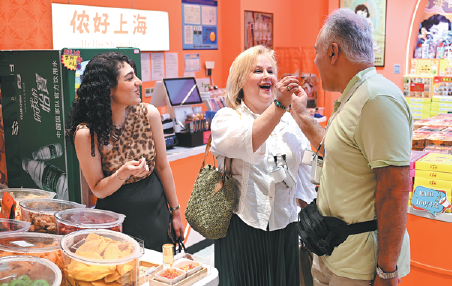
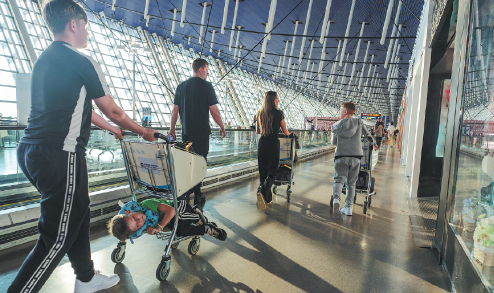
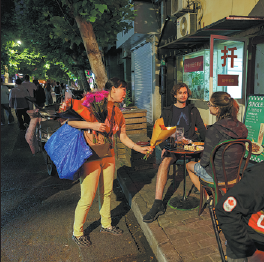
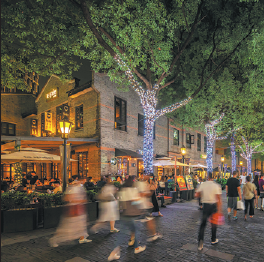

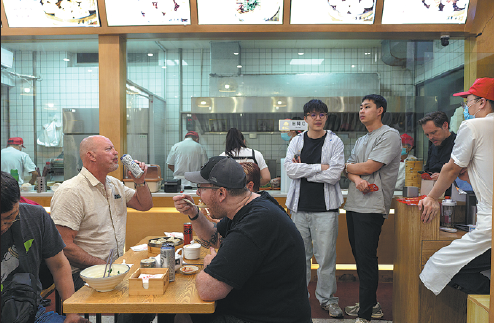
Today's Top News
- Chinese premier urges G20 to uphold free trade, build open world economy
- China, US hold maritime safety talks in Hawaii as Beijing reiterates warnings on sovereignty
- China sends letter to UN over Japanese PM's remarks on Taiwan
- Chinese, Uzbek FMs hold second strategic dialogue
- G20 an opportunity to strengthen Sino-EU ties
- China, Africa foster shared food security






















